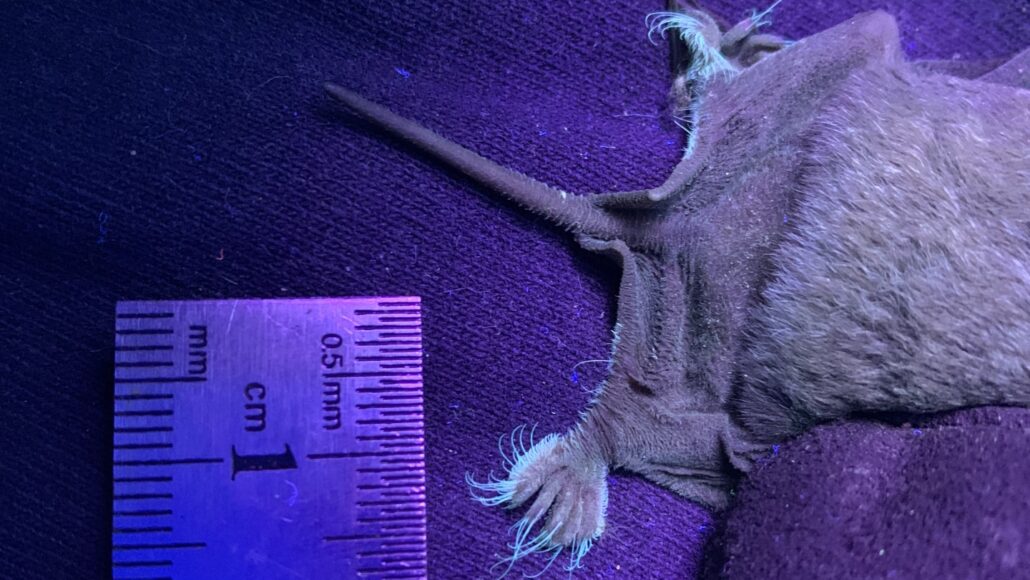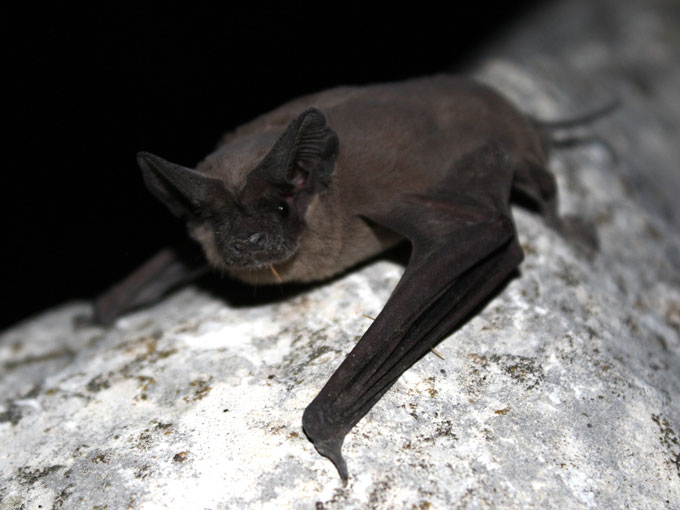Weird? These bat toes can glow greenish-blue
Scientists were surprised by this fluorescence in Mexican free-tailed bats

Under ultraviolet light, bristles on the toes of this Mexican free-tailed bat glow a brilliant blue-green.
F. Gual-Suárez
By Jason Bittel
You’ve heard of jazz hands? These bats have glow toes.
When ultraviolet (UV) light shines onto the Mexican free-tailed bat’s hairy toes, they light up. That glow is called photoluminescence. It happens when bristles on the toes absorb UV light, which our eyes can’t see. The bristles then re-emit that energy as light in a blue-green wavelength, which we can see.
Scientists have been finding more and more animals that can glow like this. Wasp nests, platypuses, flying squirrels and tardigrades all do it. But most of these animals’ whole bodies glow under UV light. In Mexican free-tailed bats (Tadarida brasiliensis), it’s just the toes.
Researchers found out about the toe glow by accident. They were trying to use a photoluminescent powder to track bats in Mexico.
“We failed at that,” says Fernando Gual-Suárez. He’s a biologist at the National Autonomous University of Mexico in Mexico City. But while they were using UV flashlights to search for signs of the powder, the team saw those glow-in-the-dark toes.
“Is that normal? Do the feet usually look like that?” Gual-Suárez remembers another scientist asking.
Do you have a science question? We can help!
Submit your question here, and we might answer it an upcoming issue of Science News Explores
Scientists already knew that the toes on this species are strange.
These and related bats “have what are termed ‘spoon-shaped bristles’ along the outer edges” of some of their toes, notes Nancy Simmons. She’s a bat expert at the American Museum of Natural History in New York City. She did not take part in the new work. “Nobody has ever known why [the bats] have these bristles in the first place,” Simmons says.
But it’s these bristles that glow under UV light.
Gual-Suárez’ team shared its new findings August 8 in Mammalian Biology. It’s the first time photoluminescent structures have been reported in live bats, they say.
Witnessing the value of field studies
The researchers found similarly bright fluorescent bristles on 25 live Mexican free-tailed bats. They came from two sites. The same glowing bristles showed up on a bat captured more than 700 kilometers (435 miles) north of the others.
The team also tested dead bats kept in museums for research. Their toe bristles didn’t fluoresce. But their bodies glowed a dull green all over when bathed in UV light. That’s probably because of chemicals used for preservation, the researchers say. It may also be due to other physical changes that occur in the specimens as they age.
That finding shows scientists would have missed the toe glow “if they’d have used museum specimens instead” of live bats, says Linda Reinhold. She’s a zoologist at James Cook University in Cairns, Australia. She calls the work by Gual-Suárez and his colleagues “good science.”
It’s not clear what purpose the toe glow might have. Scientists don’t even know if the bats can see the glow. And since the bats are nocturnal, they would likely encounter UV light mostly at dusk, dawn and in moonlight.

This species lives in colonies that can run to millions of bats. Such hordes need to coordinate migrations in the dark over of thousands of kilometers. The researchers say it would make sense if the light-up bristles played some role in communication at night.
“We need to test it in the lab,” says ecologist Rodrigo Medellín. He’s a coauthor, also at the National Autonomous University of Mexico. His team is thinking of keeping the bats captive and shaving the bristles off their feet. Afterward, they could test whether this affects the animals.
“This is just scratching the surface of a very deep and very long iceberg that nobody knows anything about,” he says of the mysterious glowing toes.







